Radiation Synthesis of Pentaethylene Hexamine Functionalized Cotton Linter for Effective Removal of Phosphate: Batch and Dynamic Flow Mode Studies
Abstract
1. Introduction
2. Experimental
2.1. Materials
2.2. Preparation of Quaternized Cotton Linter Fiber (QCLF)
2.3. Characterization
2.4. Batch Adsorption Experiments
2.5. Column Experiments
3. Results and Discussion
3.1. Synthesis of the QCLF
3.2. Characterization
3.2.1. FT-IR Analysis
3.2.2. SEM Photographs
3.2.3. TG Analysis
3.3. Phosphate Adsorption in Batch Experiments
3.3.1. pH Study
3.3.2. Effect of Adsorbent Dosage
3.3.3. Adsorption Kinetics
3.3.4. Adsorption Isotherms
3.4. Column Experiments
3.4.1. Effect of Influent Concentration
3.4.2. Effect of Flow Rate
3.4.3. Estimation of Breakthrough Curve
3.4.4. Elution Experiment
4. Conclusions
Author Contributions
Funding
Conflicts of Interest
References
- Bulgariu, D.; Axinte, O.; Badescu, I.S.; Stroe, C.; Neacsu, V.; Bulgariu, L. Evolution of trophic parameters from amara lake. Environ. Eng. Manag. J. 2015, 14, 559–565. [Google Scholar] [CrossRef]
- Hossain, M.E.; Ritt, C.L.; Almeelbi, T.B.; Bezbaruah, A.N. Biopolymer Beads for Aqueous Phosphate Removal: Possible Applications in Eutrophic Lakes. J. Environ. Eng. 2018, 144, 04018030. [Google Scholar] [CrossRef]
- Loganathan, P.; Vigneswaran, S.; Kandasamy, J.; Bolan, N.S. Removal and Recovery of Phosphate from Water Using Sorption. Crit. Rev. Environ. Sci. Technol. 2014, 44, 847–907. [Google Scholar] [CrossRef]
- Ye, Y.; Jiao, J.; Kang, D.; Jiang, W.; Kang, J.; Ngo, H.H.; Guo, W.; Liu, Y. The adsorption of phosphate using a magnesia–pullulan composite: Kinetics, equilibrium, and column tests. Environ. Sci. Pollut. Res. 2019, 26, 13299–13310. [Google Scholar] [CrossRef] [PubMed]
- Li, R.; Wang, J.J.; Zhou, B.; Awasthi, M.K.; Ali, A.; Zhang, Z.; Lahori, A.H.; Mahar, A. Recovery of phosphate from aqueous solution by magnesium oxide decorated magnetic biochar and its potential as phosphate-based fertilizer substitute. Bioresour. Technol. 2016, 215, 209–214. [Google Scholar] [CrossRef]
- Sud, D.; Mahajan, G.; Kaur, M. Agricultural waste material as potential adsorbent for sequestering heavy metal ions from aqueous solutions–A review. Bioresour. Technol. 2008, 99, 6017–6027. [Google Scholar] [CrossRef]
- Zou, H.; Lv, P.-F.; Wang, X.; Wu, D.; Yu, D.-G. Electrospun poly(2-aminothiazole)/cellulose acetate fiber membrane for removing Hg(II) from water. J. Appl. Polym. Sci. 2017, 134, 44879. [Google Scholar] [CrossRef]
- Monier, M.; Ayad, D.M.; Sarhan, A.A. Adsorption of Cu(II), Hg(II), and Ni(II) ions by modified natural wool chelating fibers. J. Hazard. Mater. 2010, 176, 348–355. [Google Scholar] [CrossRef]
- Du, J.; Dong, Z.; Pi, Y.; Yang, X.; Zhao, L. Fabrication of Cotton Linter-Based Adsorbents by Radiation Grafting Polymerization for Humic Acid Removal from Aqueous Solution. Polymers 2019, 11, 962. [Google Scholar] [CrossRef]
- Hassan, M.S.; Zohdy, M.H. Adsorption Kinetics of Toxic Heavy Metal Ions from Aqueous Solutions onto Grafted Jute Fibers with Acrylic Acid by Gamma Irradiation. J. Nat. Fibers 2018, 15, 506–516. [Google Scholar] [CrossRef]
- Duan, C.; Zhao, N.; Yu, X.; Zhang, X.; Xu, J. Chemically modified kapok fiber for fast adsorption of Pb, Cd, Cu from aqueous solution. Cellulose 2013, 20, 849–860. [Google Scholar] [CrossRef]
- Nguyen, D.D.; Vu, C.M.; Vu, H.T.; Choi, H.J. Micron-Size White Bamboo Fibril-Based Silane Cellulose Aerogel: Fabrication and Oil Absorbent Characteristics. Materials 2019, 12, 1407. [Google Scholar] [CrossRef] [PubMed]
- Dong, C.; Zhang, H.; Pang, Z.; Liu, Y.; Zhang, F. Sulfonated modification of cotton linter and its application as adsorbent for high-efficiency removal of lead(II) in effluent. Bioresour. Technol. 2013, 146, 512–518. [Google Scholar] [CrossRef] [PubMed]
- Li, Y.; Xiao, H.; Pan, Y.; Wang, L. Novel Composite Adsorbent Consisting of Dissolved Cellulose Fiber/Microfibrillated Cellulose for Dye Removal from Aqueous Solution. ACS Sustain. Chem. Eng. 2018, 6, 6994–7002. [Google Scholar] [CrossRef]
- Qu, R.; Sun, C.; Wang, M.; Ji, C.; Xu, Q.; Zhang, Y.; Wang, C.; Chen, H.; Yin, P. Adsorption of Au(III) from aqueous solution using cotton fiber/chitosan composite adsorbents. Hydrometallurgy 2009, 100, 65–71. [Google Scholar] [CrossRef]
- Araga, R.; Sharma, C.S. Amine Functionalized Electrospun Cellulose Nanofibers for Fluoride Adsorption from Drinking Water. J. Polym. Environ. 2019, 27, 816–826. [Google Scholar] [CrossRef]
- Tian, Y.; Wu, M.; Liu, R.; Wang, D.; Lin, X.; Liu, W.; Ma, L.; Li, Y.; Huang, Y. Modified native cellulose fibers—A novel efficient adsorbent for both fluoride and arsenic. J. Hazard. Mater. 2011, 185, 93–100. [Google Scholar] [CrossRef]
- Yu, X.; Tong, S.; Ge, M.; Wu, L.; Zuo, J.; Cao, C.; Song, W. Synthesis and characterization of multi-amino-functionalized cellulose for arsenic adsorption. Carbohydr. Polym. 2013, 92, 380–387. [Google Scholar] [CrossRef]
- Hayashi, N.; Chen, J.; Seko, N. Nitrogen-Containing Fabric Adsorbents Prepared by Radiation Grafting for Removal of Chromium from Wastewater. Polymers 2018, 10, 744. [Google Scholar] [CrossRef]
- Le Moigne, N.; Sonnier, R.; El Hage, R.; Rouif, S. Radiation-induced modifications in natural fibres and their biocomposites: Opportunities for controlled physico-chemical modification pathways? Ind. Crop. Prod. 2017, 109, 199–213. [Google Scholar] [CrossRef]
- Du, J.; Dong, Z.; Yang, X.; Zhao, L. Facile fabrication of sodium styrene sulfonate-grafted ethylene-vinyl alcohol copolymer as adsorbent for ammonium removal from aqueous solution. Environ. Sci. Pollut. Res. 2018, 25, 27235–27244. [Google Scholar] [CrossRef] [PubMed]
- Chattopadhyay, D.; Umrigar, K. Chemical Modification of Waste Cotton Linters for Oil Spill Cleanup Application. J. Inst. Eng. (India) Ser. E 2017, 98, 103–120. [Google Scholar] [CrossRef]
- Anbia, M.; Salehi, S. Removal of acid dyes from aqueous media by adsorption onto amino-functionalized nanoporous silica SBA-3. Dyes Pigments 2012, 94, 1–9. [Google Scholar] [CrossRef]
- Lv, X.; Li, Y.; Yang, M. Humidity sensitive properties of copolymer of quaternary ammonium salt with polyether-salt complex. Polym. Adv. Technol. 2009, 20, 509–513. [Google Scholar] [CrossRef]
- Deng, S.; Zheng, Y.; Xu, F.; Wang, B.; Huang, J.; Yu, G. Highly efficient sorption of perfluorooctane sulfonate and perfluorooctanoate on a quaternized cotton prepared by atom transfer radical polymerization. Chem. Eng. J. 2012, 193, 154–160. [Google Scholar] [CrossRef]
- Chen, I.; Xu, C.; Peng, J.; Han, D.; Liu, S.; Zhai, M.L. Novel Functionalized Cellulose Microspheres for Efficient Separation of Lithium Ion and Its Isotopes: Synthesis and Adsorption Performance. Molecules 2019, 24, 2762. [Google Scholar] [CrossRef] [PubMed]
- Duan, P.; Xu, X.; Shang, Y.; Gao, B.; Li, F. Amine-crosslinked Shaddock Peel embedded with hydrous zirconium oxide nano-particles for selective phosphate removal in competitive condition. J. Taiwan Inst. Chem. Eng. 2017, 80, 650–662. [Google Scholar] [CrossRef]
- Naushad, M.; Sharma, G.; Kumar, A.; Sharma, S.; Ghfar, A.A.; Bhatnagar, A.; Stadler, F.J.; Khan, M.R. Efficient removal of toxic phosphate anions from aqueous environment using pectin based quaternary amino anion exchanger. Int. J. Boil. Macromol. 2018, 106, 1–10. [Google Scholar] [CrossRef]
- Muhammadj, A.; Shah, A.A.; Bilal, S.; Rahman, G. Basic Blue Dye Adsorption fromWater Using Polyaniline/Magnetite (Fe3O4) Composites: Kinetic and Thermodynamic Aspects. Materials 2019, 12, 1764. [Google Scholar] [CrossRef]
- Shaban, M.; Abukhadra, M.R.; Khan, A.A.P.; Jibali, B.M. Removal of Congo red, methylene blue and Cr(VI) ions from water using natural serpentine. J. Taiwan Inst. Chem. Eng. 2018, 82, 102–116. [Google Scholar] [CrossRef]
- Zhang, L.; Liu, J.; Guo, X. Investigation on mechanism of phosphate removal on carbonized sludge adsorbent. J. Environ. Sci. 2018, 64, 335–344. [Google Scholar] [CrossRef]
- Silva, F.; Nascimento, L.; Brito, M.; Da Silva, K.; Paschoal, W.; Fujiyama, R.; Silva, D. Biosorption of Methylene Blue Dye Using Natural Biosorbents Made from Weeds. Materials 2019, 12, 2486. [Google Scholar] [CrossRef]
- Fan, C.H.; Zhang, Y.C. Adsorption isotherms, kinetics and thermodynamics of nitrate and phosphate in binary systems on a novel adsorbent derived from corn stalks. J. Geochem. Explor. 2018, 188, 95–100. [Google Scholar] [CrossRef]
- Rashid, M.; Price, N.T.; Pinilla, M.; Ángel, G.; O’Shea, K.E. Effective removal of phosphate from aqueous solution using humic acid coated magnetite nanoparticles. Water Res. 2017, 123, 353–360. [Google Scholar] [CrossRef]
- Xu, X.; Gao, B.-Y.; Yue, Q.-Y.; Zhong, Q.-Q. Preparation of agricultural by-product based anion exchanger and its utilization for nitrate and phosphate removal. Bioresour. Technol. 2010, 101, 8558–8564. [Google Scholar] [CrossRef]
- Liu, Q.; Hu, P.; Wang, J.; Zhang, L.; Huang, R. Phosphate adsorption from aqueous solutions by Zirconium (IV) loaded cross-linked chitosan particles. J. Taiwan Inst. Chem. Eng. 2016, 59, 311–319. [Google Scholar] [CrossRef]
- Carvalho, W.S.; Martins, D.F.; Gomes, F.R.; Leite, I.R.; Da Silva, L.G.; Ruggiero, R.; Richter, E.M. Phosphate adsorption on chemically modified sugarcane bagasse fibres. Biomass Bioenergy 2011, 35, 3913–3919. [Google Scholar] [CrossRef]
- Chen, S.; Yue, Q.; Gao, B.; Li, Q.; Xu, X.; Fu, K. Adsorption of hexavalent chromium from aqueous solution by modified corn stalk: A fixed-bed column study. Bioresour. Technol. 2012, 113, 114–120. [Google Scholar] [CrossRef]
- Bulgariu, D.; Bulgariu, L. Sorption of Pb(II) onto a mixture of algae waste biomass and anion exchanger resin in a packed-bed column. Bioresour. Technol. 2013, 129, 374–380. [Google Scholar] [CrossRef]
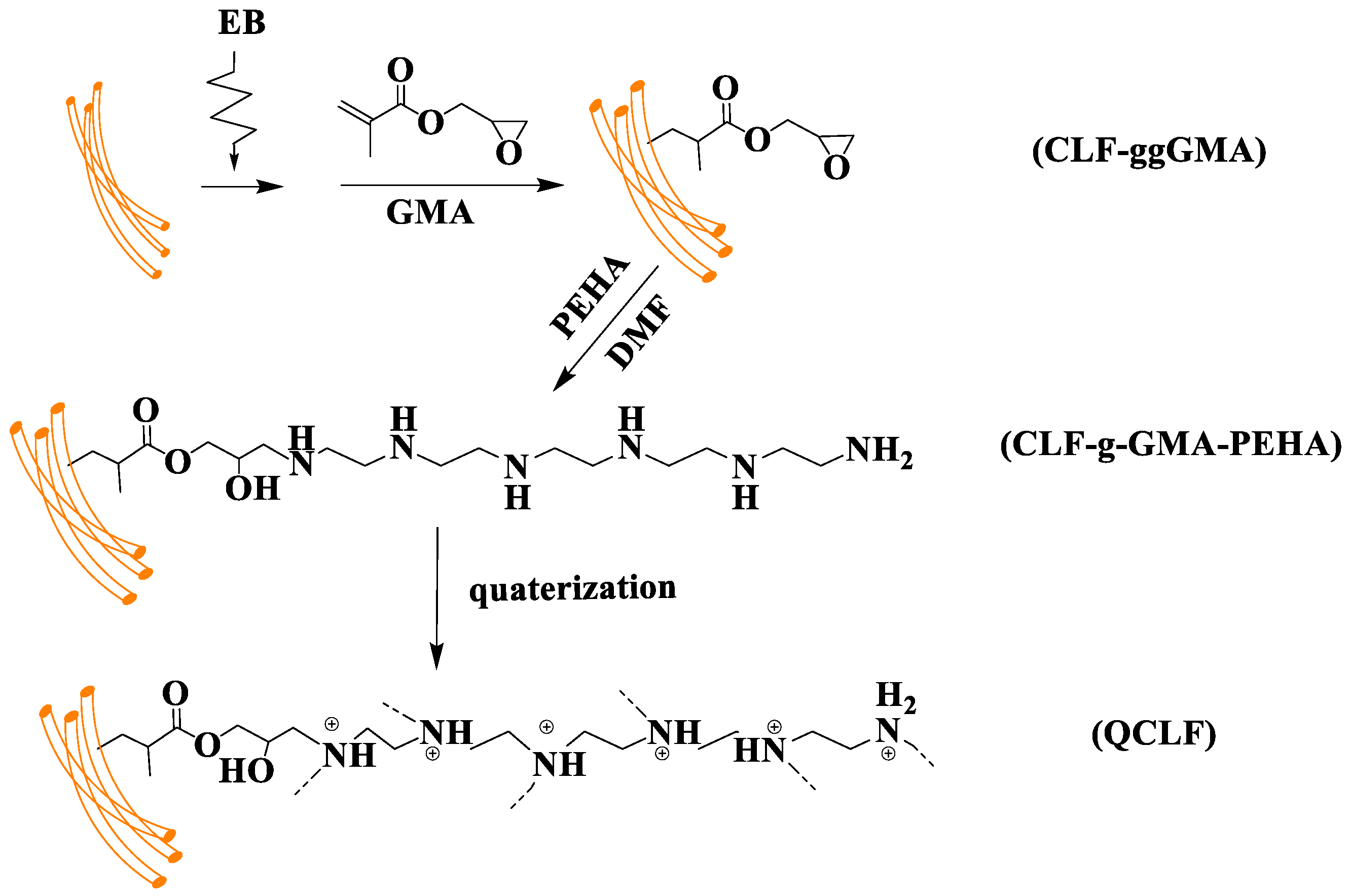
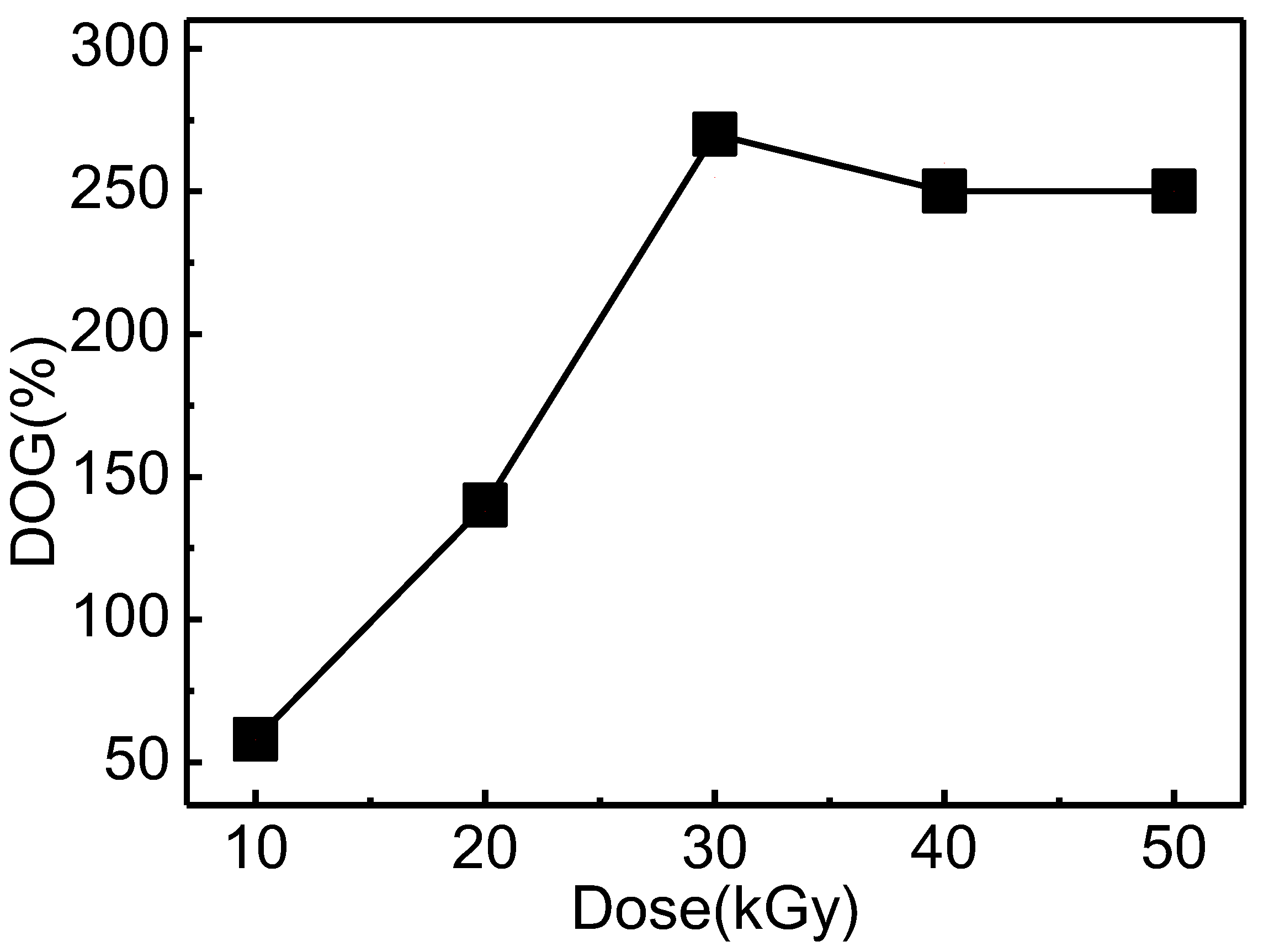
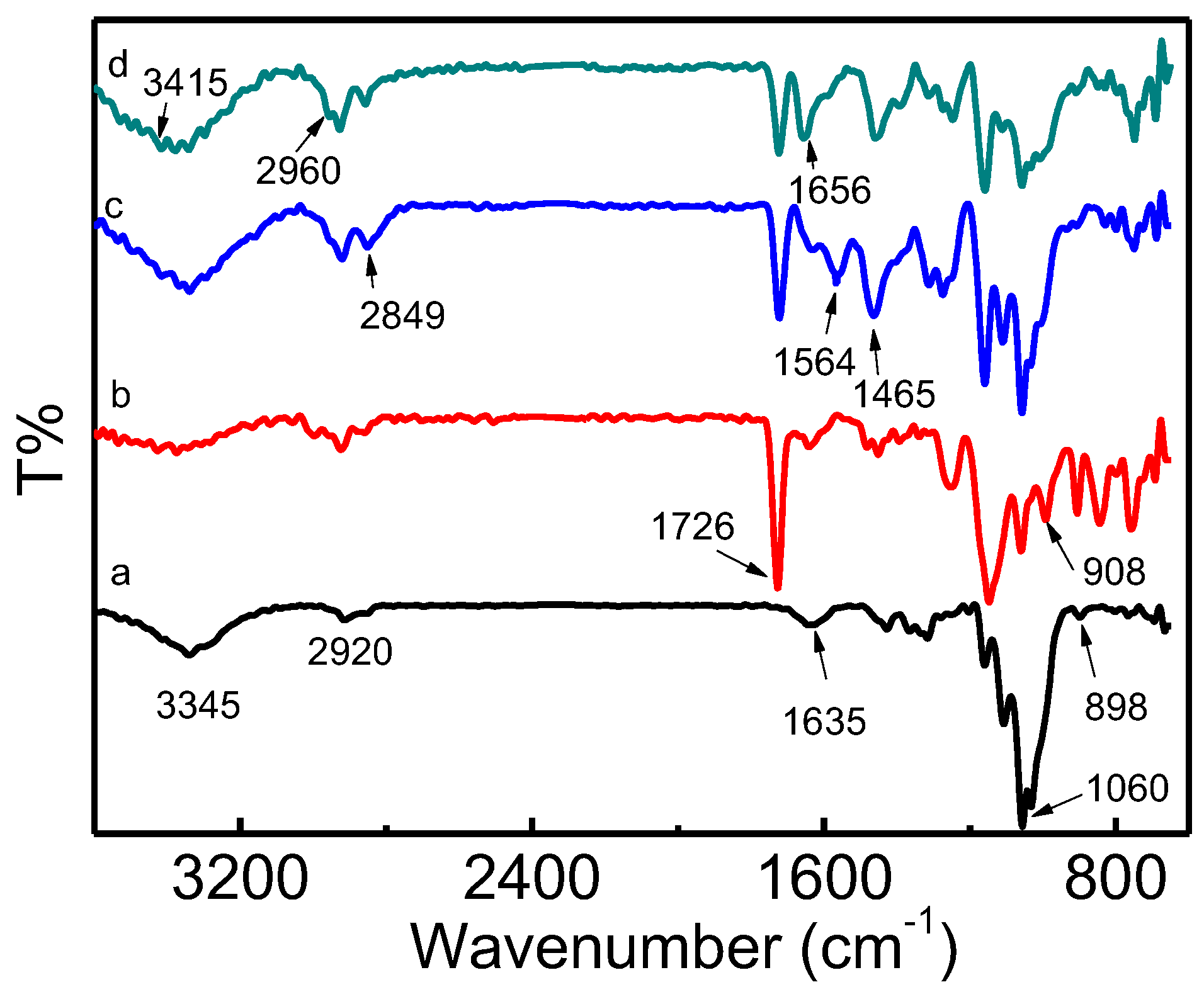
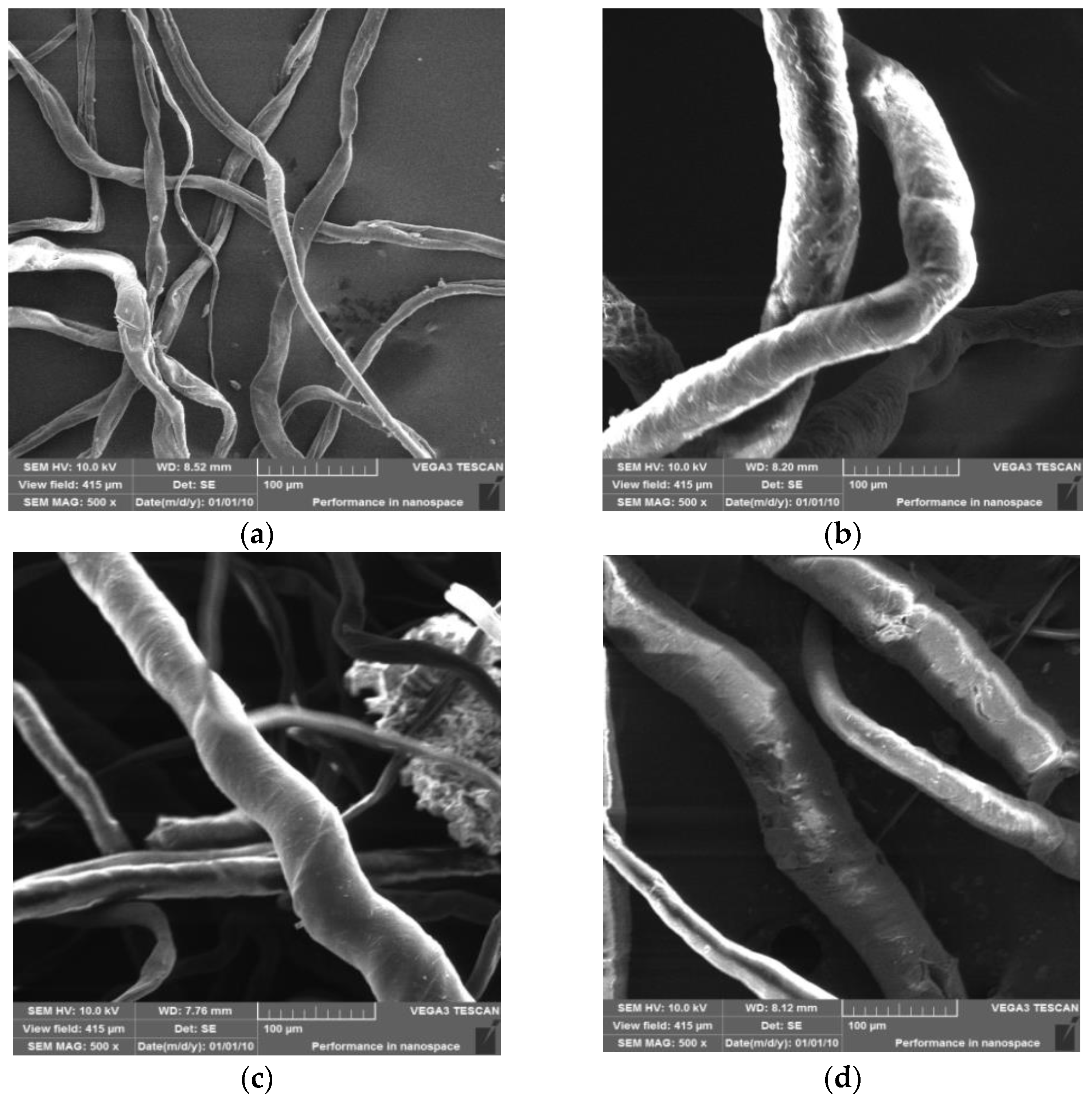
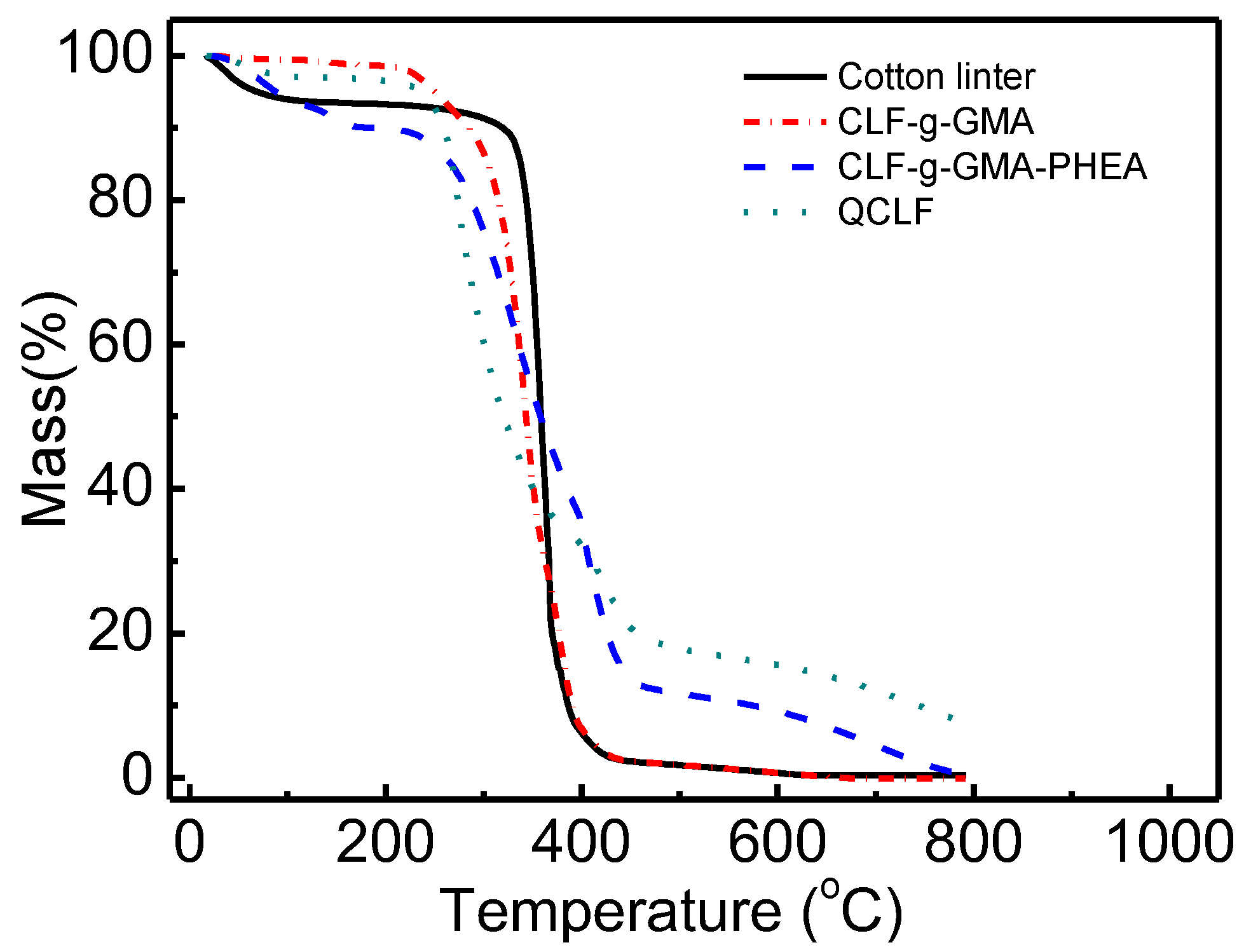
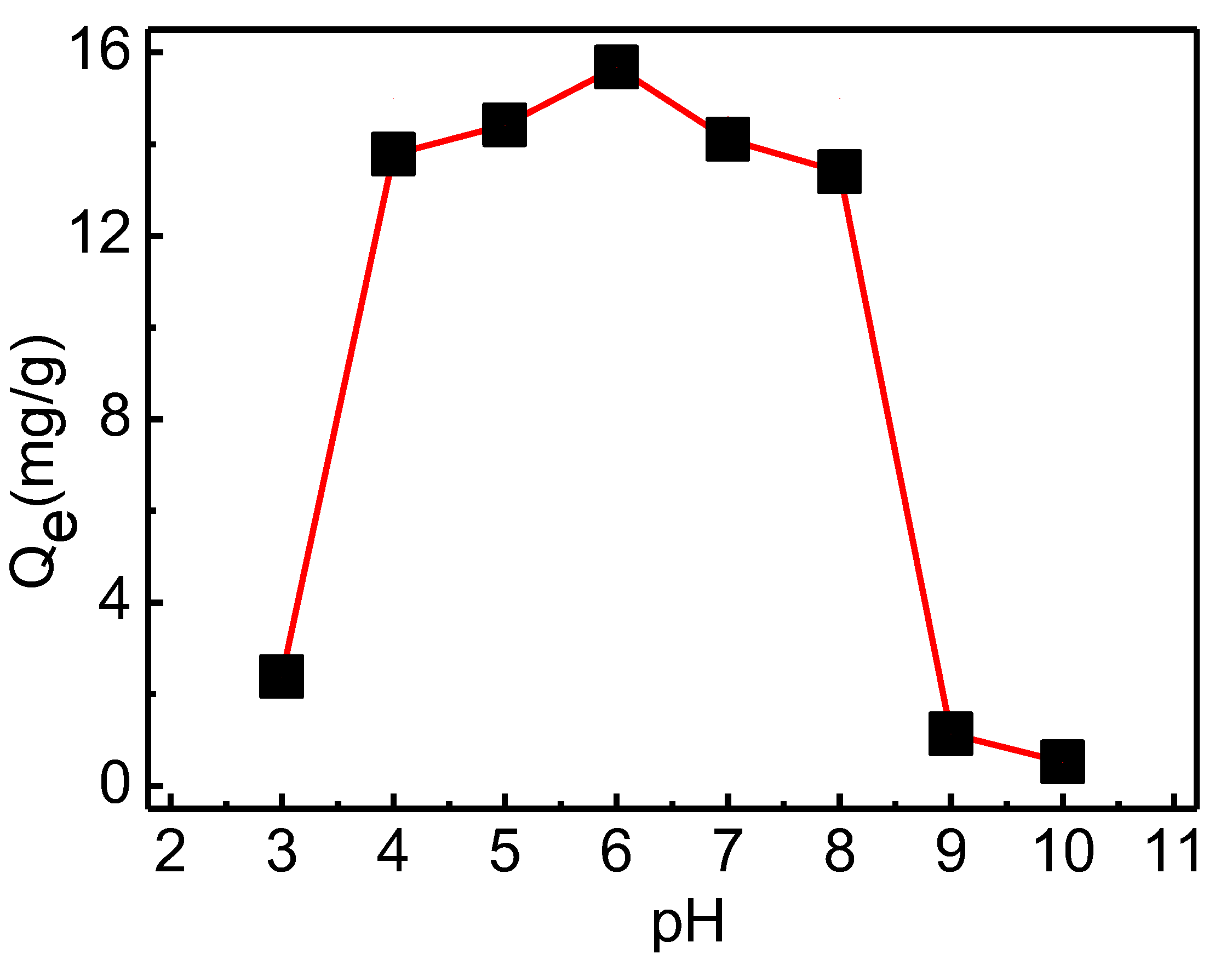
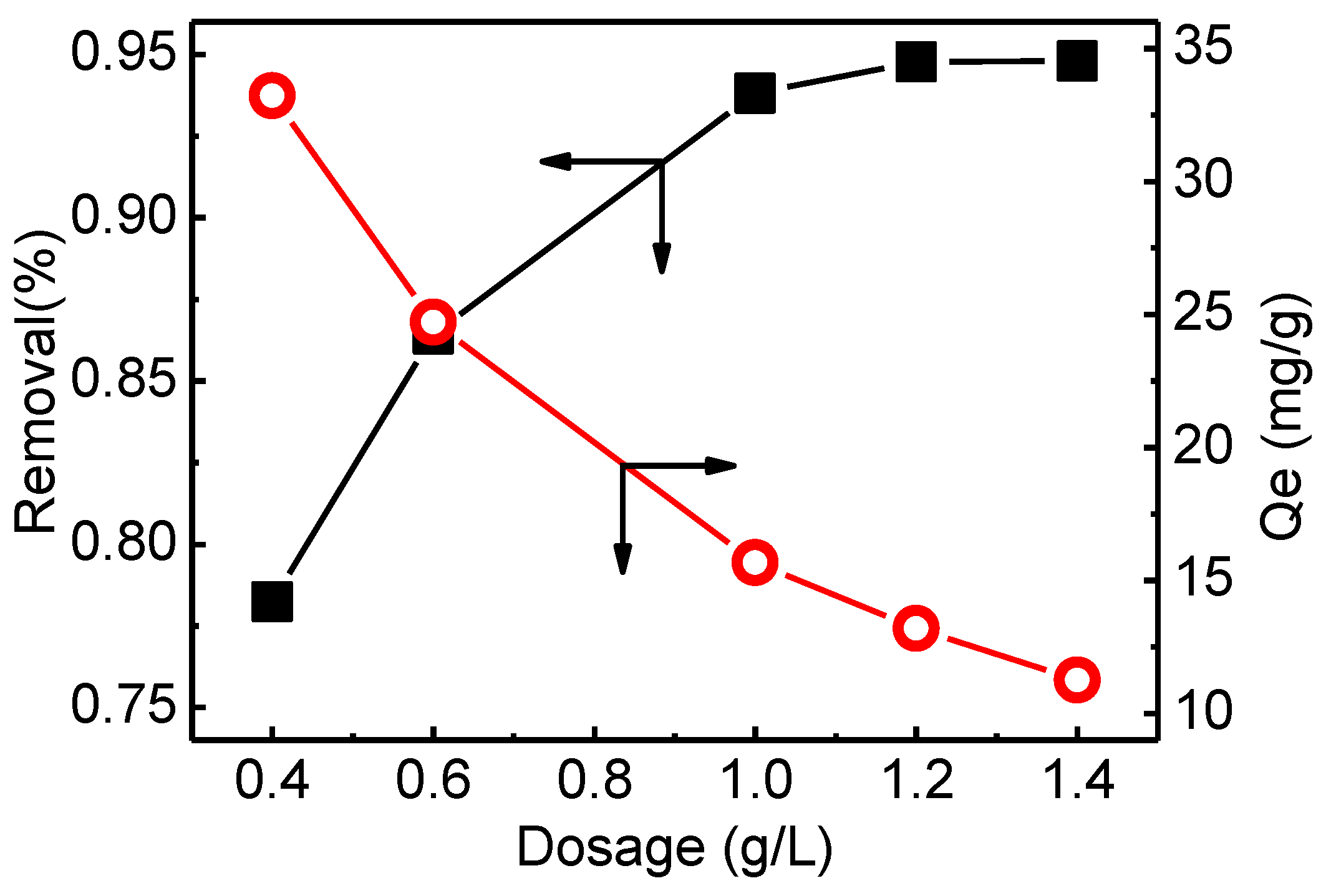

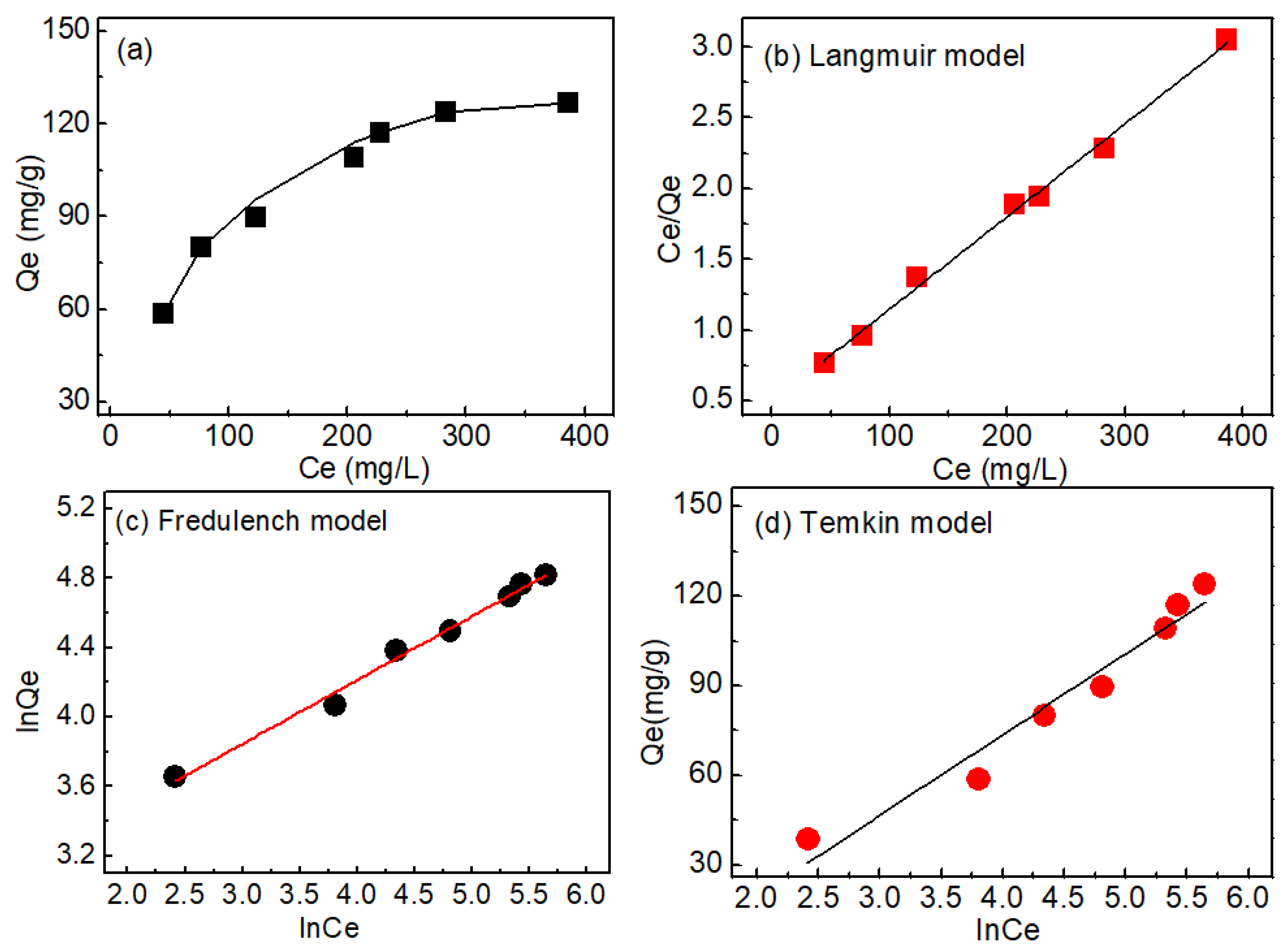
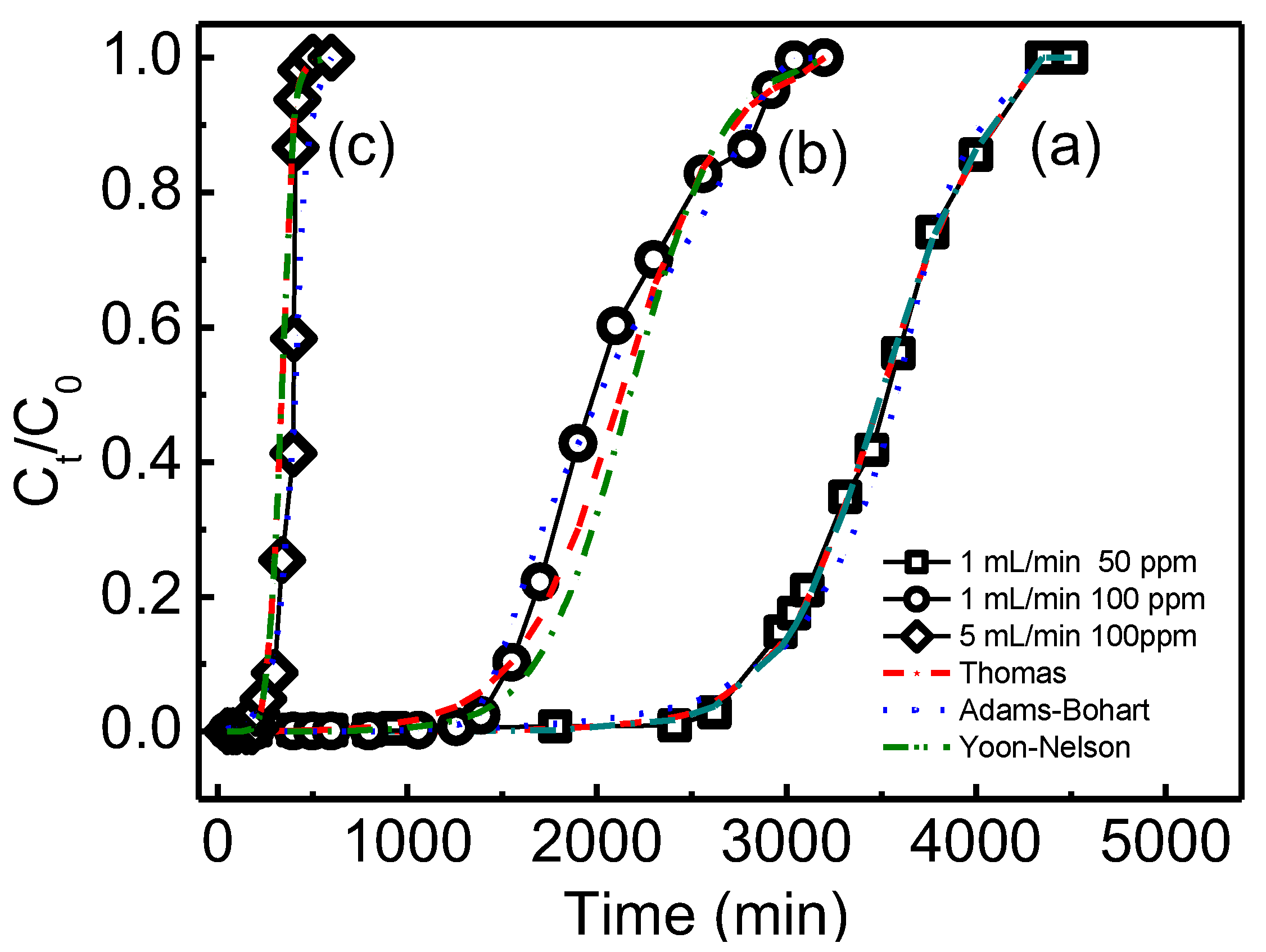
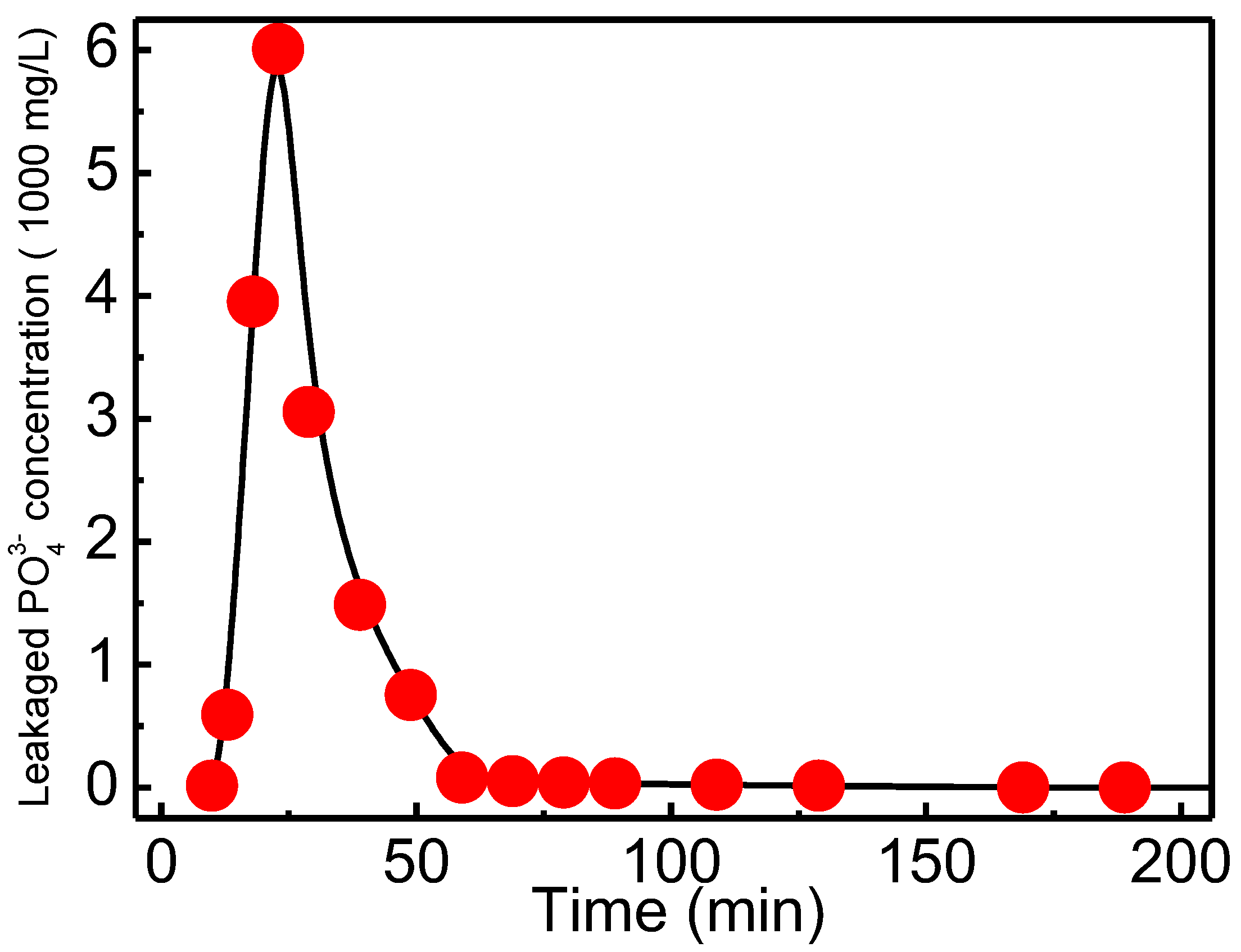
| Model | Parameters | 20 mg/L HPO42− |
|---|---|---|
| pseudo-first-order kinetics | k1 (h−1) | 0.0305 |
| qe (mg/g) | 15.314 | |
| R2 | 0.9872 | |
| pseudo-second-order kinetics | k2 (g/(mg·min)) | 0.0047 |
| qe (mg/g) | 19.409 | |
| R2 | 0.9967 | |
| Weber–Morris | Kid1 | 1.8415 |
| I1 | 1.3091 | |
| R2 | 0.97891 | |
| Kid2 | 0.4543 | |
| I2 | 9.9282 | |
| R2 | 0.9973 |
| Adsorbent | Langmuir | Freundlich | Temkin | ||||||
|---|---|---|---|---|---|---|---|---|---|
| Qm (mg/g) | KL | R2 | KF (mg·L−1) | n | R2 | BT | KT | R2 | |
| QCL | 152.44 | 0.0139 | 0.9952 | 15.52 | 2.720 | 0.9899 | 26.9827 | 0.2799 | 0.9476 |
| Adsorbent | The max Adsorption Capacity (mg/g) | pH | Reference |
|---|---|---|---|
| carbonized sludge adsorbent | 4.792 | 7 | [32] |
| diethylamine modified Cellulose | 22.88 | 6.8 | [33] |
| humic acid coated magnetite nanoparticles | 28.9 | 6.6 | [34] |
| quaternized pectin | 31.07 | 7 | [30] |
| wheat straw anion exchanger | 52.80 | - | [35] |
| amine-crosslinked Shaddock Peel | 59.89 | 3 | [27] |
| Zirconium (IV) loaded cross-linked chitosan particles | 71.68 | 3 | [36] |
| modified sugarcane bagasse fibers-Fe | 152 | 3 | [37] |
| quaternized cotton linter fiber | 152.44 | 7 | This paper |
| C0 (mg/L) | v (mL/min) | Thomas Model | Bohart-Adams Model | Yoon-Nelson Model | ||||||
|---|---|---|---|---|---|---|---|---|---|---|
| kTH | q0 | R2 | kBA | N0 | R2 | kYN | R2 | |||
| 50 | 1 | 0.0738 | 120.61 | 0.9889 | 0.0462 | 61.1088 | 0.8930 | 0.0037 | 3497.81 | 0.9889 |
| 100 | 1 | 0.0376 | 141.58 | 0.9352 | 0.0102 | 89.229545 | 0.8009 | 0.0038 | 2123.74 | 0.9352 |
| 100 | 5 | 0.3458 | 22.419 | 0.9399 | 0.1363 | 14.4303 | 0.9399 | 0.0346 | 336.63 | 0.9368 |
© 2019 by the authors. Licensee MDPI, Basel, Switzerland. This article is an open access article distributed under the terms and conditions of the Creative Commons Attribution (CC BY) license (http://creativecommons.org/licenses/by/4.0/).
Share and Cite
Du, J.; Dong, Z.; Lin, Z.; Yang, X.; Zhao, L. Radiation Synthesis of Pentaethylene Hexamine Functionalized Cotton Linter for Effective Removal of Phosphate: Batch and Dynamic Flow Mode Studies. Materials 2019, 12, 3393. https://doi.org/10.3390/ma12203393
Du J, Dong Z, Lin Z, Yang X, Zhao L. Radiation Synthesis of Pentaethylene Hexamine Functionalized Cotton Linter for Effective Removal of Phosphate: Batch and Dynamic Flow Mode Studies. Materials. 2019; 12(20):3393. https://doi.org/10.3390/ma12203393
Chicago/Turabian StyleDu, Jifu, Zhen Dong, Zhiyuan Lin, Xin Yang, and Long Zhao. 2019. "Radiation Synthesis of Pentaethylene Hexamine Functionalized Cotton Linter for Effective Removal of Phosphate: Batch and Dynamic Flow Mode Studies" Materials 12, no. 20: 3393. https://doi.org/10.3390/ma12203393
APA StyleDu, J., Dong, Z., Lin, Z., Yang, X., & Zhao, L. (2019). Radiation Synthesis of Pentaethylene Hexamine Functionalized Cotton Linter for Effective Removal of Phosphate: Batch and Dynamic Flow Mode Studies. Materials, 12(20), 3393. https://doi.org/10.3390/ma12203393





